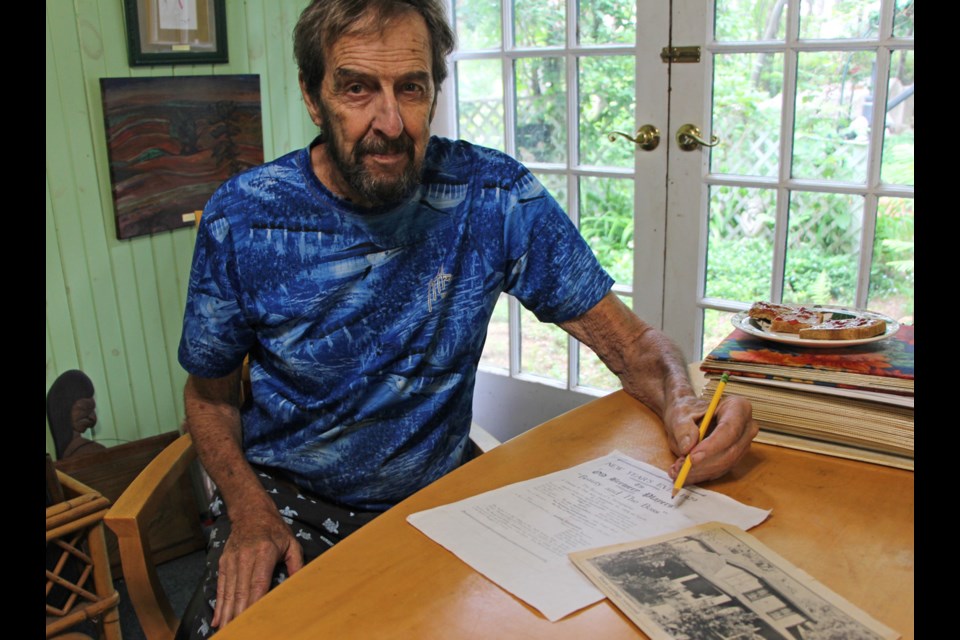When the Couchiching Craft Brewing Co. opened in 2020, it was celebrated as the first brewery in Orillia. It is certainly the first brewery to open in the City of Orillia, but not the first to open in the former village of Orillia.
The names Brewery Lane and Old Brewery Bay have more significance than the popular association with Stephen Leacock, whose summer home – now a National Historic Site – was located on this quiet bay in Lake Couchiching.
The name Brewery Bay predates Leacock’s tenure by many years and, in fact, represents the location of a former brewery. In the mid-1800s, Jackson’s Brewery was located on the west side of the bay, producing “spirits brewed with fine lake water” until about 1870, when it was destroyed by fire.
According to the Orillia Heritage Conservation District Study conducted in 2010, “Orillia in the mid-19th century was a rough place, characterized by drunken and disorderly behaviour, thanks to the lumbermen and railwaymen who crowded into town on paydays.”
In other historical documents, it is reported that Orillia was known as “the hardest drinking village in Ontario.”
From all reports, Jackson’s Brewery operated during what has been described as a rowdy, bawdy era, one that ended with the temperance movement and prohibition.
The preservation of this interesting era in Orillia’s history has been of particular interest to local artist, Jimi McKee. McKee and his family lived at the site of Jackson’s Brewery for a number of years.
“The Old Brewery,” as our house was known, has left us with many fond memories,” said McKee.
Although all that was left of the original brewery was the stone foundation of the beverage room, the house they lived in still remains on the site and has a fascinating history of its own.
“We purchased the property in 1977, just before Brewery Lane was re-developed. The original Heward home was one of the few homes on the point. Our house at the brewery property had actually been moved to the site after the brewery burned down,” explained McKee.
“The house originally stood on the corner of Peter and Tecumseth Streets. It was moved across the lake by a team of horses during the winter sometime between 1914 and 1917 and was rebuilt on the Old Brewery property. It was purchased by Dr. Ardagh for his son, who was unfortunately killed in the war.”
Consequently, Dr. Ardagh rented the house to artist, Mae Shaw, who would become a close friend and confidante of Stephen Leacock’s during the last two decades of his life. This is where the history of Old Brewery Bay gets more intriguing.
“When we found the house in 1977, it had all but collapsed, but we dedicated ourselves to renovating and restoring it,” said McKee.
In the process, Jimi and his wife Karen discovered the original beauty of the house as well as many artifacts providing clues to the life and times of its previous occupants.
In addition to remnants of sailing vessels, liquor bottles and old playbills, the McKees discovered the existence of a well-worn path at the foot of the bay between the Old Brewery Bay house and Leacock’s home.
“Leacock and Mae Shaw were very close and appeared to have spent time together racing sailboats, entertaining and presenting dramatic performances,” said McKee. “Mae Shaw created the Old Brewery Players, a group of family, friends and neighbours, who used to act out Leacock’s stories before they were published,” added McKee.
“The living room with its balcony, 25-foot ceiling and massive fireplace had an incredible warmth about it. We learned that this room and the adjacent verandah were where the performances would have taken place.”
McKee described a large sign with lights and the words “Old Brewery Players” that was found under the house. “I’m sure that this was footlights. There were also life-size paintings of the actors on the living room wall, but they were cut out of the wall by the previous owner, Warren Doner. I assume they’re somewhere with the family’s archives.”
The McKees said that during their years at the Brewery Bay house, they had many visitors who would share stories about the history of the activities at Old Brewery Bay.
“From what I’ve heard, Mae Shaw and Leacock enjoyed a close relationship and counted on each other. I think his writing would have been affected by the wonderful relationship they had,” said McKee.
The McKees were dedicated to reviving the history of Old Brewery Bay and the grand house on the property, which still remains amidst a more modern-looking Brewery Lane.
“The history of this property is fascinating and shouldn’t be lost,” said McKee.
Rowdy and bawdy or not, the McKees hope the work they did to retain and share the character of the Old Brewery Bay property has helped to highlight the importance of this era in the history of Orillia.
Thank you to the Orillia Public Library – the Orilliana Room – and Amy Lambertsen for providing information for this story.
